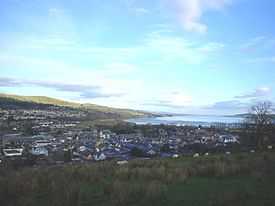Battle of Dingwall
| Battle of Dingwall | |||||||
|---|---|---|---|---|---|---|---|
| Part of the Scottish clan wars | |||||||
 Modern day Dingwall looking out towards the Cromarty Firth | |||||||
| |||||||
| Belligerents | |||||||
|
Clan Donald and followers (Loyal to Donald of Islay) |
Clan Mackay and followers (Loyal to Stewart royal family) | ||||||
| Commanders and leaders | |||||||
| Donald of Islay, Lord of the Isles | Angus Du Mackay, 7th of Strathnaver | ||||||
| Strength | |||||||
| 10,000 men[1] | 4000 men[2] | ||||||
| Casualties and losses | |||||||
| Unknown | Unknown | ||||||
| ||||||
The Battle of Dingwall was a Scottish clan battle said to have taken place in the year 1411, in Dingwall in the Scottish Highlands. It was fought between the Clan Mackay against the Clan Donald.
Accounts of the Battle
Sir Robert Gordon
Sir Robert Gordon, from his book the "Genealogical History of the Earldom of Sutherland":
This Angus-Dow Mackay fought against Donald, Lord of the Isles at Dingwall in Ross, because that Donald had molested some friends which Angus-Dow had in that country. At this conflict Angus Dow was overcome and taken prisoner, and his brother Rory-Gald, with divers others, were slain. Donald of the Isles having detained Angus-Dow a while in captivity, released him, and gave him his daughter in marriage, whom Angus-Dow carried home with him to Strathnaver, and had a son by her, called Niel-Wass, so named because he was imprisoned in the Bass.[3]
Robert Mackay
Robert Mackay gives an account of the battle in his book "History of the House and Clan of Mackay" (1829), quoting from the "A Genealogical History of the Earldom of Sutherland" by Sir Robert Gordon:
Donald of the Isles, says Sir Robert, conceived such indignation and displeasure at his being deprived of the earldom, that he raised all the power of the Isles, and invaded and spoiled the country of Ross, where he was met by Angus-Dow Mackay, some of whose friends he had injured; a severe conflict ensued, when Mackay, overpowered by numbers, was overcome, his brother Roderick slain, and himself taken prisoner. Emboldened by this victory, Donald marched through Inverness and Murray, threatening to destroy all before him, which issued in the well known Battle of Harlaw, fought in the year 1411; in which there were slain on Donald's part, MacLean and MacKintosh, and on the other side Sir Alexander Ogilvy, Sir James Scrimeor, Sir Alexander Irvine of Drum, Sir William Aberthy of Saltoun, Sir Robert Maule of Panmure, Sir Robert Davidson, and divers other gentlemen.[4]
Aftermath
In the aftermath of the Battle of Dingwall and the Battle of Harlaw, according to 17th century historian Sir Robert Gordon, chief Angus Du Mackay married a daughter of Donald MacDonald, Lord of the Isles.[5] However 19th century historian, Angus Mackay, states that chief Angus Du Mackay actually married a sister of the Lord of the Isles, not his daughter.[6]
References
- ↑ Mackenzie, Alexander. (1881). History of the Macdonalds and Lords of the Isles; with genealogies of the principal families of the name. Inverness: A. & W. Mackenzie. pp. 62.
- ↑ Mackay, Angus. M.A. (1906). The Book of Mackay. pp. 55.
- ↑ Gordon, Sir Robert (1580–1656). A Genealogical History of the Earldom of Sutherland. Written in 1625. Republished in 1813. pp. 63.
- ↑ Mackay, Robert. (1829). History of the House and Clan of Mackay. pp. 53 - 54, quoting: Gordon, Sir Robert. (1580 to 1656). A Genealogical History of the Earldom of Sutherland.
- ↑ Mackay, Robert. (1829). History of the House and Clan of Mackay. pp. 53 - 56.
- ↑ Mackay, Angus. M.A. (1906). The Book of Mackay. pp. 61.